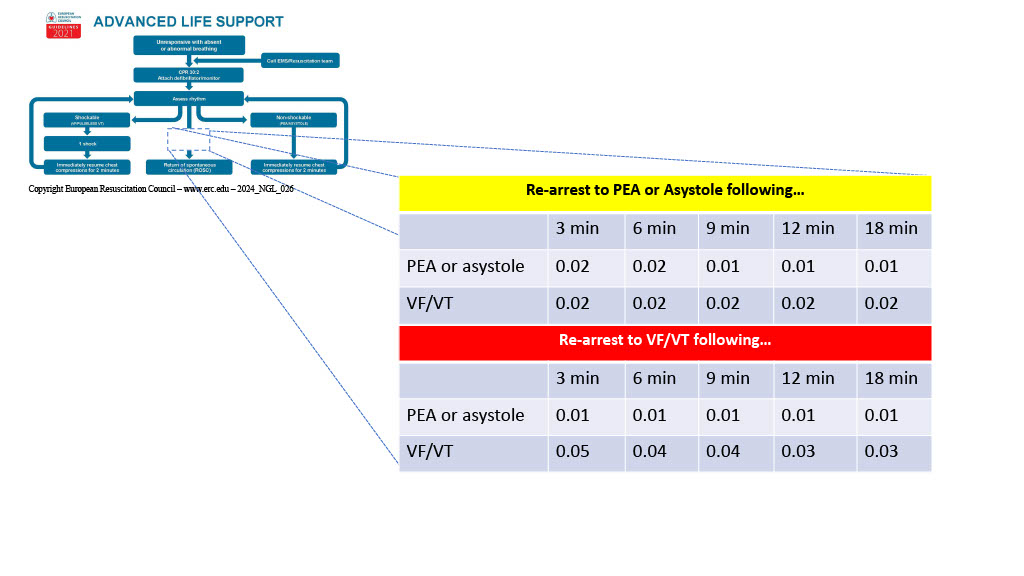Final ID: Sa902
Re-arrest Immediately after Return of Spontaneous Circulation
Abstract Body: Introduction: Patients who regain return of spontaneous circulation (ROSC) after in-hospital cardiac arrest are often critically ill and at risk of re-arrest. However, re-arrest is insufficiently studied. Pre-hospital data indicate a re-arrest rate ranging from 3% to 39%. Our study aims to assess the immediate hazard of re-arrest after ROSC, depending on whether the patient’s last observed rhythm before ROSC was shockable or not.
Methods: We analyzed defibrillator recordings and clinical data from 763 cardiac arrest episodes at four different hospitals. ROSC was defined as an organized ECG rhythm compatible with a pulse, accompanied by the absence of chest compressions for at least one minute. An organized rhythm with a QRS frequency ≥ 12 was categorized as pulseless electrical activity (PEA). Conversely, a QRS frequency < 12 or a flat line represented asystole. Ventricular fibrillation or tachycardia (VF/VT) was identified based on its distinct morphology. We further stratified ROSC based on whether the preceding rhythm was shockable or not. After comparing four different parametric time-to-event models, we chose the most useful one and estimated the immediate hazard of re-arrest along the timeline of resuscitation.
Results: After the initial event of cardiac arrest, we observed 316 re-arrests. Among these, 68% relapsed to PEA, 25% relapsed to VF/VT, and 7% relapsed to asystole. Summarized in the figure, the initial hazard of re-arrest from ROSC after PEA or asystole to a non-shockable rhythm was 0.02 per minute. By the 9th minute, this hazard decreased to 0.01 per minute. Meanwhile, the hazard for re-arrest to a shockable rhythm remained constant at 0.01 per minute. For re-arrest from ROSC after VF/VT back to VF/VT, the hazard was 0.05 per minute initially, decreasing to 0.03 per minute by the 12th minute. The corresponding hazard for re-arrest to PEA or asystole remained at 0.01 per minute.
Conclusion: The hazard of re-arrest after return of spontaneous circulation (ROSC) to either pulseless electrical activity (PEA), asystole, or ventricular fibrillation/tachycardia (VF/VT) varies by the last observed state before ROSC. Notably, re-arrest to VF/VT following ROSC after previous VF/VT poses the highest risk. This understanding can assist healthcare professionals in anticipating events during the critical minutes following successful resuscitation and adjusting treatment accordingly.
Methods: We analyzed defibrillator recordings and clinical data from 763 cardiac arrest episodes at four different hospitals. ROSC was defined as an organized ECG rhythm compatible with a pulse, accompanied by the absence of chest compressions for at least one minute. An organized rhythm with a QRS frequency ≥ 12 was categorized as pulseless electrical activity (PEA). Conversely, a QRS frequency < 12 or a flat line represented asystole. Ventricular fibrillation or tachycardia (VF/VT) was identified based on its distinct morphology. We further stratified ROSC based on whether the preceding rhythm was shockable or not. After comparing four different parametric time-to-event models, we chose the most useful one and estimated the immediate hazard of re-arrest along the timeline of resuscitation.
Results: After the initial event of cardiac arrest, we observed 316 re-arrests. Among these, 68% relapsed to PEA, 25% relapsed to VF/VT, and 7% relapsed to asystole. Summarized in the figure, the initial hazard of re-arrest from ROSC after PEA or asystole to a non-shockable rhythm was 0.02 per minute. By the 9th minute, this hazard decreased to 0.01 per minute. Meanwhile, the hazard for re-arrest to a shockable rhythm remained constant at 0.01 per minute. For re-arrest from ROSC after VF/VT back to VF/VT, the hazard was 0.05 per minute initially, decreasing to 0.03 per minute by the 12th minute. The corresponding hazard for re-arrest to PEA or asystole remained at 0.01 per minute.
Conclusion: The hazard of re-arrest after return of spontaneous circulation (ROSC) to either pulseless electrical activity (PEA), asystole, or ventricular fibrillation/tachycardia (VF/VT) varies by the last observed state before ROSC. Notably, re-arrest to VF/VT following ROSC after previous VF/VT poses the highest risk. This understanding can assist healthcare professionals in anticipating events during the critical minutes following successful resuscitation and adjusting treatment accordingly.
More abstracts on this topic:
Acceptability and Effectiveness of a Novel, Video-Based CPR and AED Education Program in Canadian Schools
Allan Katherine, Dhillon Santokh, Mcculloch Holly, Ruether Kim, Zotzman Jeanine, Blanchard Ian, Janczyszyn Mike, Wong Natalie, Oneil Emma, Sapp John
A Multicentre Study for Hands Only CPR (HOCPR) training assessment towards building a ‘Nation of Life Savers” in IndiaRavikumar Thanjavur, Sarma Kvs, Ravikumar Thanjavur, Sarkar Manuj, Debnath Dhrubajyoti, Behera Priyamadhaba, Ghate Jayshri, Trikha Divay, Samantaray A, Madhavi K

